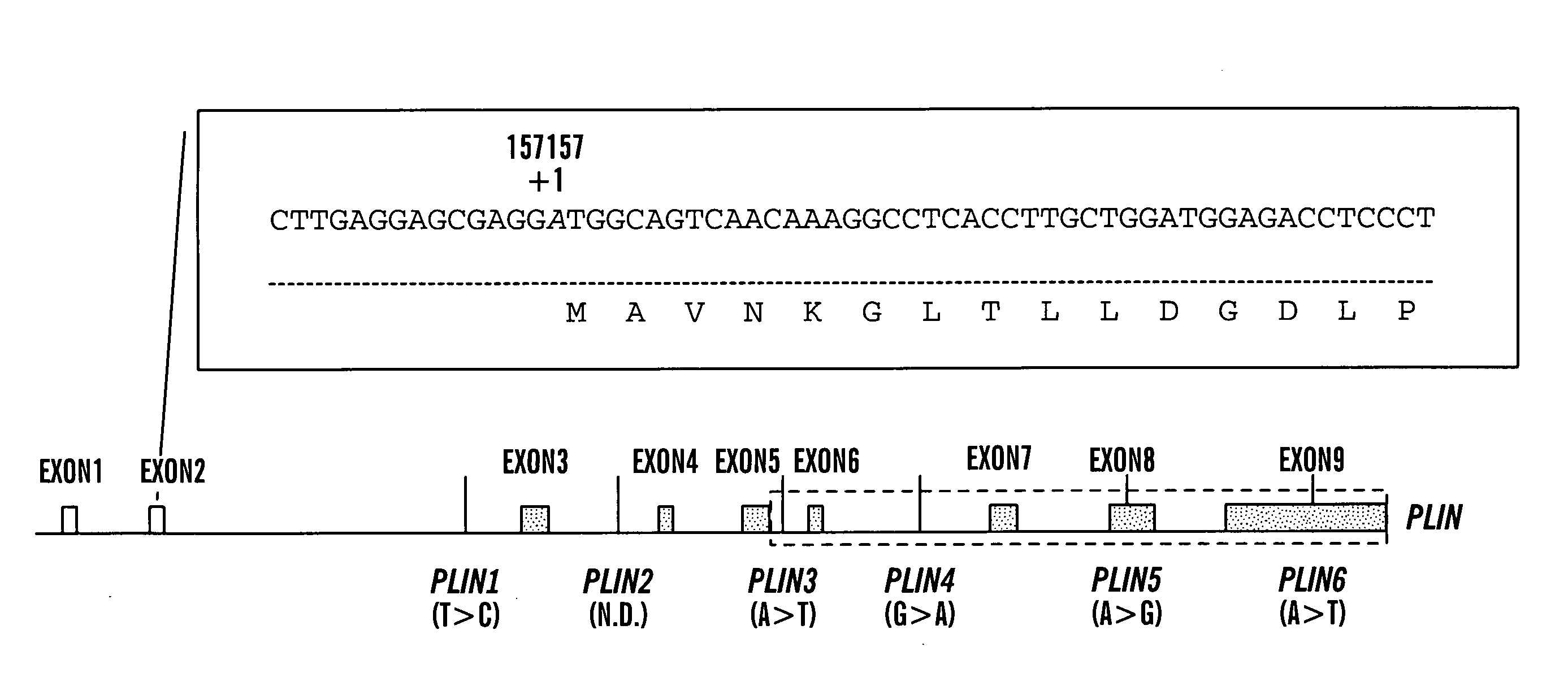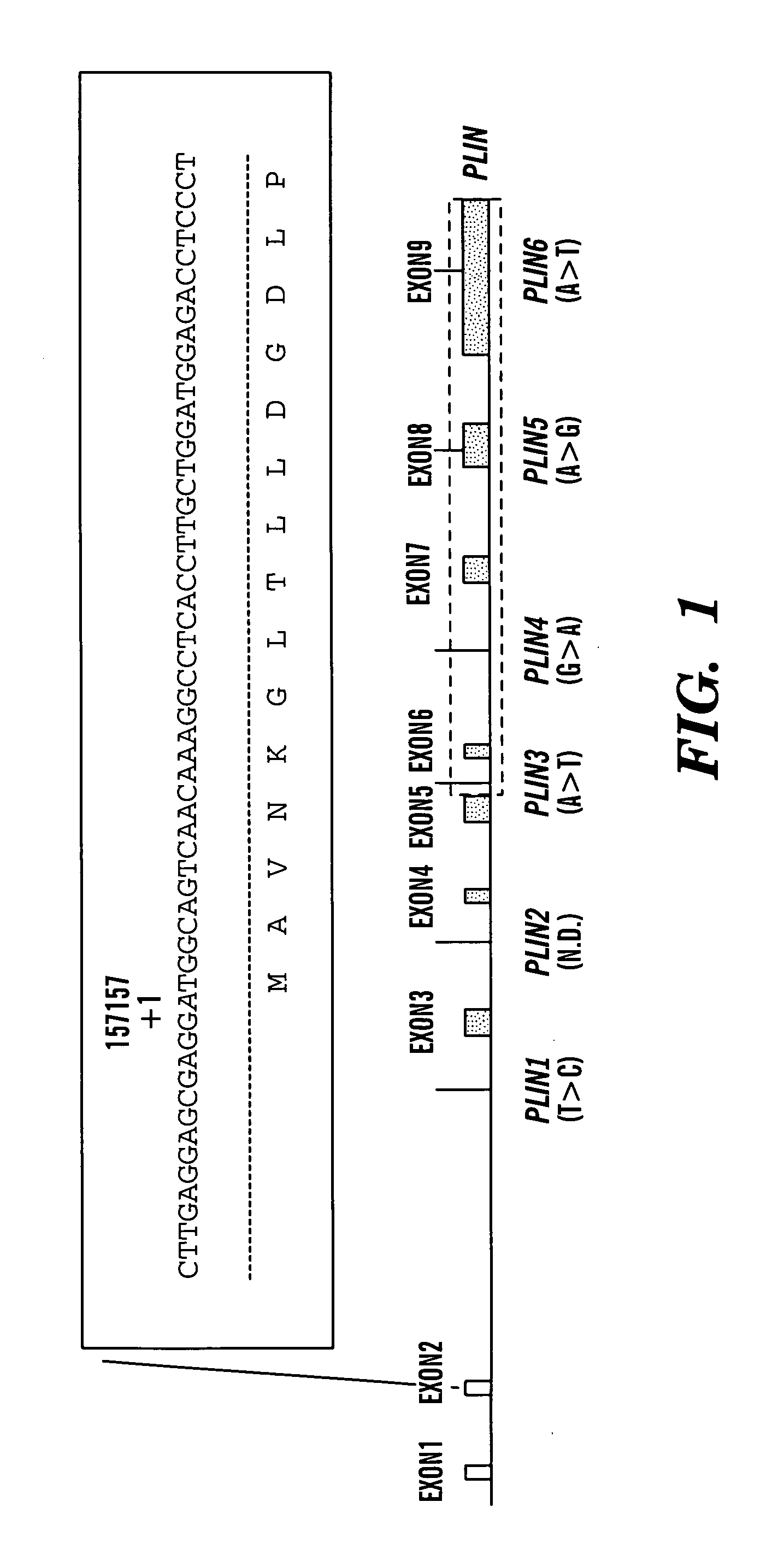Genetic markers for obesity
a genetic marker and obesity technology, applied in the field of genetic markers for obesity, can solve the problems of complex role of genetic factors, severe epidemic of obesity and related metabolic diseases, and inadequate current regimes for treating disorders of adipose tissue metabolism, so as to and reduce the risk of obesity
- Summary
- Abstract
- Description
- Claims
- Application Information
AI Technical Summary
Benefits of technology
Problems solved by technology
Method used
Image
Examples
example 1
Gender-Specific Effects of PLIN Polymorphisms on Obesity-Related Variables in Individuals from the Eastern Mediterranean Coast of Spain
Materials and Methods
Subjects and Study Design
[0102] In total, 1746 white unrelated subjects were included in this report. The study population comprised 1589 individuals randomly selected from the Valencia Region on the Eastern Mediterranean coast of Spain (sample 1), and 157 obese subjects (sample 2), from the University General Hospital, located in the same geographical area. Briefly, sample 1 consisted of 788 men and 801 women, aged 18-85 years, who were chosen among individuals participating in a study aimed to ascertain the prevalence of both genetic and environmental cardiovascular risk factors in the Mediterranean Spanish population (14, 15). This sample comprised randomly selected workers, using a continuously updated computerized population register, as well as subjects randomly selected from the general population (15, 16). All these ...
example 1 references
[0129] 1. Hager J, Dina C, Francke S, Dubois S, Houari M, Vatin V, Vaillant E, Lorentz N, Basdevant A, Clement K, Guy-Grand B, and Froguel P (1998) A genome-wide scan for human obesity genes reveals a major susceptibility locus on chromosome 10. Nat. Genet., 20, 304-308. [0130] 2. Zamani, M., Pociot, F., Raeymaekers, P., Nerup, J., and Cassiman, J. J. (1996) Linkage of type I diabetes to 15q26 (IDDM3) in the Danish population. Hum. Genet., 98, 491-496. [0131] 3. Greenberg A S, Egan J J, Wek S A, Garty N B, Blanchette-Mackie E J, and Londos C (1991) Perilipin, a major hormonally regulated adipocyte-specific phosphoprotein associated with the periphery of lipid storage droplets. J. Biol. Chem., 266, 11341-11346. [0132] 4. Greenberg A S, Egan J J, Wek S A, Moos M C, Jr., Londos C, and Kimmel A R (1993) Isolation of cDNAs for perilipins A and B: sequence and expression of lipid droplet-associated proteins of adipocytes. Proc. Natl. Acad. Sci. U.S.A, 90, 12035-12039. [0133] 5. Nishiu J, ...
example ii
Gender Specific Association of a Perilipin (PLIN) Gene Haplotype with Obesity Risk in a White population from America
Materials and Methods
Subjects and Study Design
[0153] A total of 734 White subjects, 373 males (mean age 58.6 years) and 361 females (mean age 56.1 years) attending a residential lifestyle intervention program (The Pritikin Longevity Center, Santa Monica, Calif.) (19) were included in this study. In this population, current smoking was reported by 10.2%, and alcohol consumption (>1 drink / week) by 46.8% of the subjects. Medication use was as follows: 10.1% were taking hypoglycemic agents, 16.1% were on cholesterol-lowering drugs, 14.9% were on thyroid medication, and 35.7% of female subjects were on hormone replacement therapy. Due to limitations in DNA availability, genotypes were successfully obtained from 706 subjects for PLIN 6209T>C and 13041A>G, as well as from 705 subjects for PLIN 11482G>A and 14995A>T. Obesity was defined as BMI≧30 kg / m2. There were no sig...
PUM
| Property | Measurement | Unit |
|---|---|---|
| concentrations | aaaaa | aaaaa |
| weight | aaaaa | aaaaa |
| volume | aaaaa | aaaaa |
Abstract
Description
Claims
Application Information
 Login to View More
Login to View More - R&D
- Intellectual Property
- Life Sciences
- Materials
- Tech Scout
- Unparalleled Data Quality
- Higher Quality Content
- 60% Fewer Hallucinations
Browse by: Latest US Patents, China's latest patents, Technical Efficacy Thesaurus, Application Domain, Technology Topic, Popular Technical Reports.
© 2025 PatSnap. All rights reserved.Legal|Privacy policy|Modern Slavery Act Transparency Statement|Sitemap|About US| Contact US: help@patsnap.com



